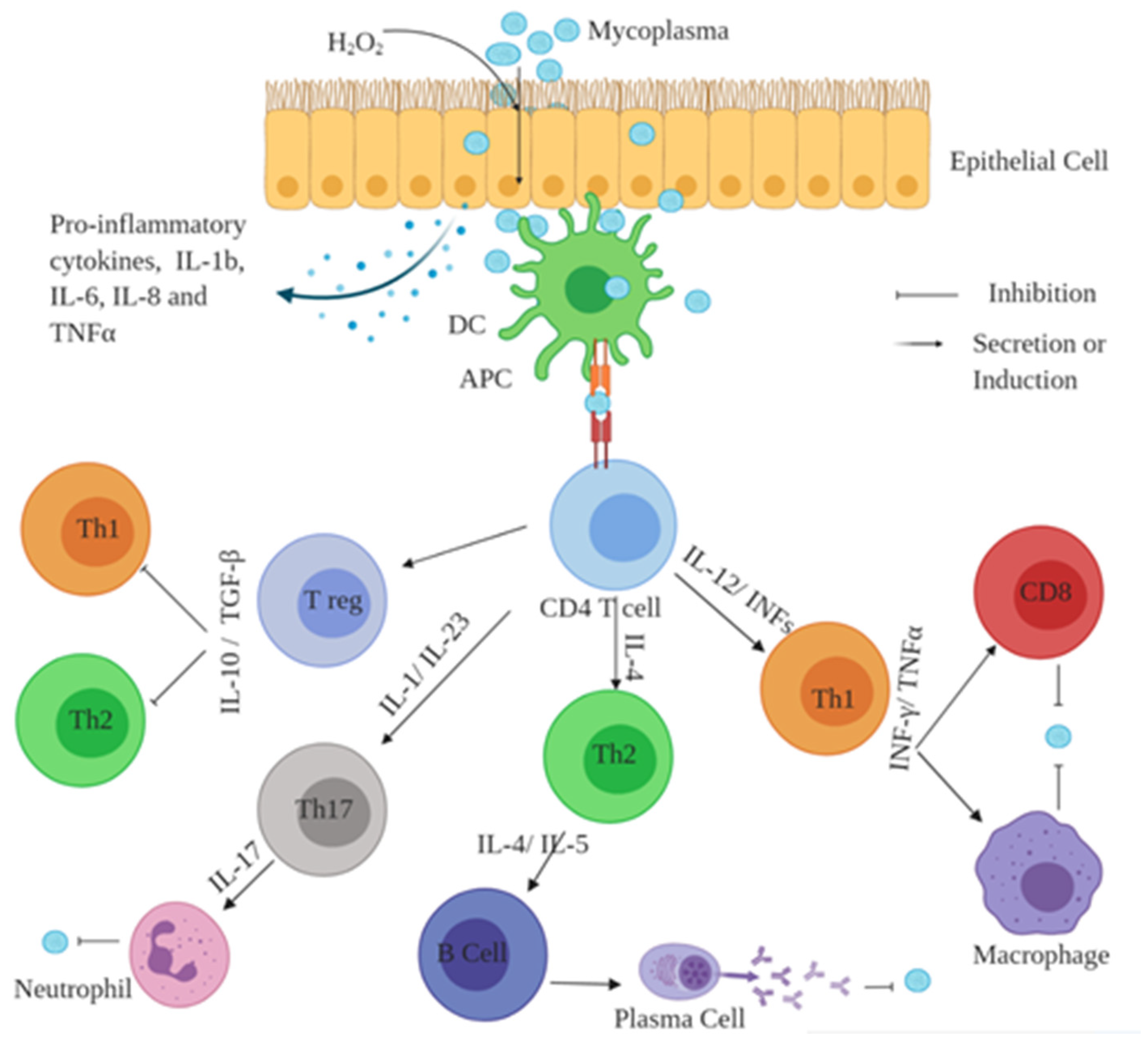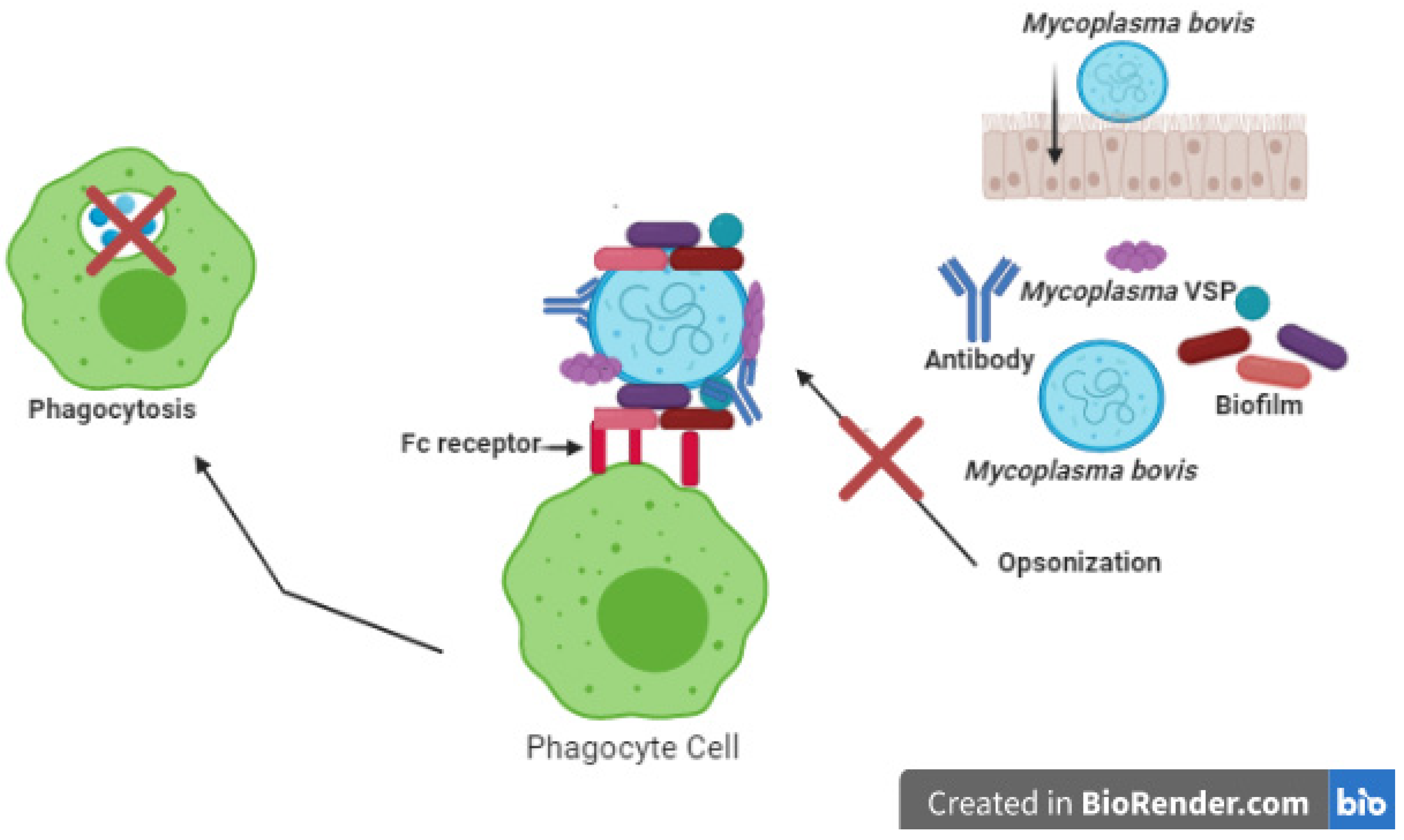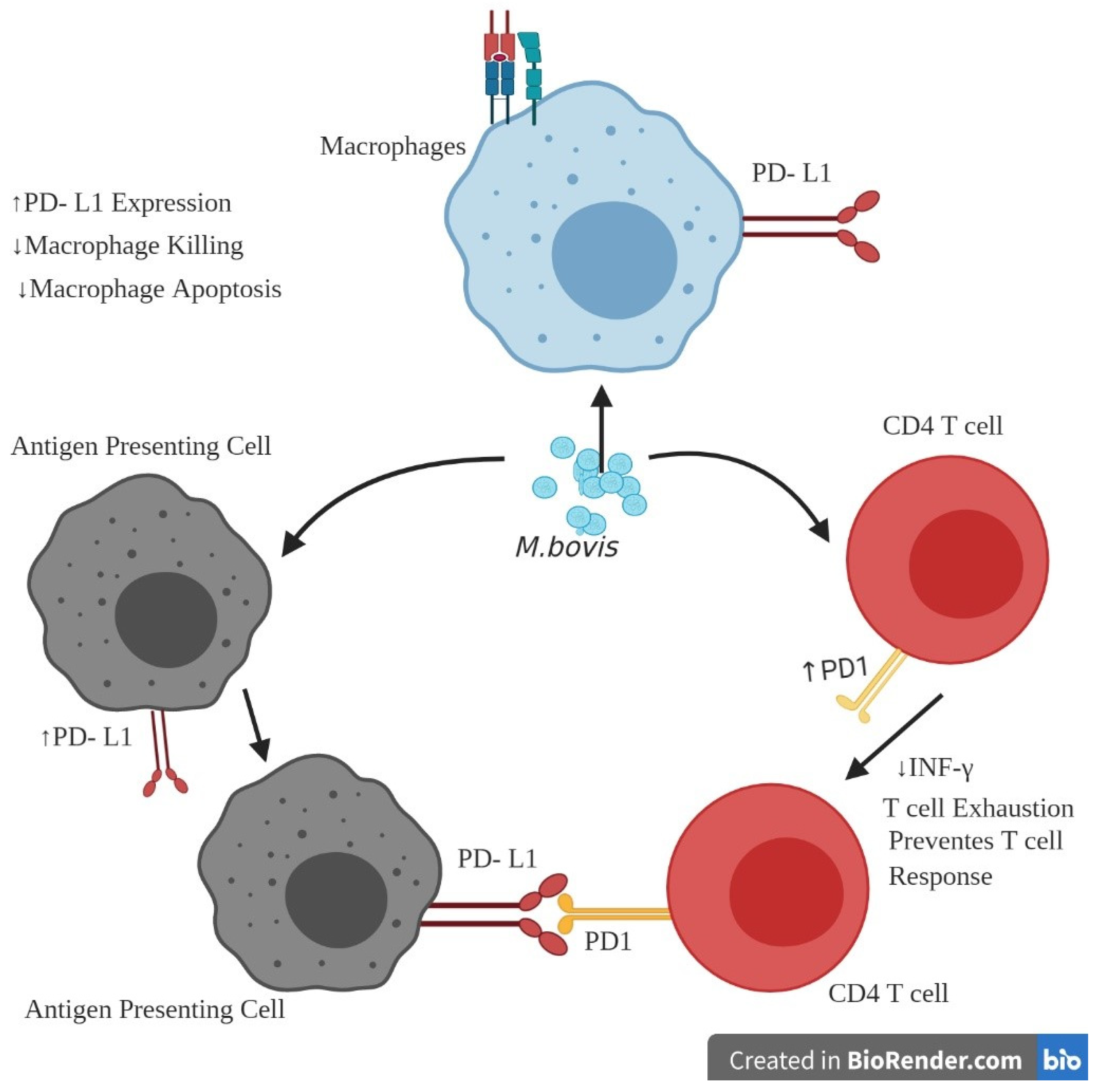Immune Evasion of Mycoplasma bovis
Abstract
1. Introduction
2. The Immune Response to M. bovis
2.1. Humoral and Cellular Immunity
2.2. Mucosal Immunity
3. Strategies Associated with the Host
3.1. Escape from Innate Immune Response
3.2. Escape from Adaptive Immune Response
3.3. Cytokine Release during M. bovis Infection
3.4. Immune Response Exhaustion during M. bovis Infection
4. Conclusions
Author Contributions
Funding
Institutional Review Board Statement
Informed Consent Statement
Data Availability Statement
Conflicts of Interest
References
- Dudek, K.; Bednarek, D.; Ayling, R.D.; Kycko, A.; Szacawa, E.; Karpinska, T.A. An experimental vaccine composed of two adjuvants gives protection against Mycoplasma bovis in calves. Vaccine 2016, 34, 3051–3058. [Google Scholar] [CrossRef]
- Maunsell, F.P.; Woolums, A.R.; Francoz, D.; Rosenbusch, R.F.; Step, D.L.; Wilson, D.J.; Janzen, E.D. Mycoplasma bovis infections in cattle. J. Vet. Intern. Med. 2011, 25, 772–783. [Google Scholar] [CrossRef]
- Nicholas, R.A. Bovine mycoplasmosis: Silent and deadly. Vet. Rec. 2011, 168, 459–462. [Google Scholar] [CrossRef] [PubMed]
- Fox, L.K. Mycoplasma mastitis: Causes, transmission, and control. Vet. Clin. N. Am. Food Anim. Pract. 2012, 28, 225–237. [Google Scholar] [CrossRef]
- Higuchi, H.; Gondaira, S.; Iwano, H.; Hirose, K.; Nakajima, K.; Kawai, K.; Hagiwara, K.; Tamura, Y.; Nagahata, H. Mycoplasma species isolated from intramammary infection of Japanese dairy cows. Vet. Rec. 2013, 172, 557. [Google Scholar] [CrossRef]
- Hertl, J.A.; Schukken, Y.H.; Welcome, F.L.; Tauer, L.W.; Grohn, Y.T. Pathogen-specific effects on milk yield in repeated clinical mastitis episodes in Holstein dairy cows. J. Dairy Sci. 2014, 97, 1465–1480. [Google Scholar] [CrossRef]
- Kroemer, S.; Galland, D.; Guerin-Faublee, V.; Giboin, H.; Woehrle-Fontaine, F. Survey of marbofloxacin susceptibility of bacteria isolated from cattle with respiratory disease and mastitis in Europe. Vet. Rec. 2012, 170, 53. [Google Scholar] [CrossRef]
- van der Merwe, J.; Prysliak, T.; Perez-Casal, J. Invasion of bovine peripheral blood mononuclear cells and erythrocytes by Mycoplasma bovis. Infect. Immun. 2010, 78, 4570–4578. [Google Scholar] [CrossRef] [PubMed]
- Mulongo, M.; Prysliak, T.; Scruten, E.; Napper, S.; Perez-Casal, J. In vitro infection of bovine monocytes with Mycoplasma bovis delays apoptosis and suppresses production of gamma interferon and tumor necrosis factor alpha but not interleukin-10. Infect. Immun. 2014, 82, 62–71. [Google Scholar] [CrossRef] [PubMed]
- Thomas, L.H.; Howard, C.J.; Parsons, K.R.; Anger, H.S. Growth of Mycoplasma bovis in organ cultures of bovine foetal trachea and comparison with Mycoplasma dispar. Vet. Microbiol. 1987, 13, 189–200. [Google Scholar] [CrossRef]
- Dyer, N.; Hansen-Lardy, L.; Krogh, D.; Schaan, L.; Schamber, E. An outbreak of chronic pneumonia and polyarthritis syndrome caused by Mycoplasma bovis in feedlot bison (Bison bison). J. Vet. Diagn. Investig. 2008, 20, 369–371. [Google Scholar] [CrossRef]
- Maeda, T.; Shibahara, T.; Kimura, K.; Wada, Y.; Sato, K.; Imada, Y.; Ishikawa, Y.; Kadota, K. Mycoplasma bovis-associated suppurative otitis media and pneumonia in bull calves. J. Comp. Pathol. 2003, 129, 100–110. [Google Scholar] [CrossRef]
- Srikumaran, S.; Kelling, C.L.; Ambagala, A. Immune evasion by pathogens of bovine respiratory disease complex. Anim. Health Res. Rev. 2007, 8, 215–229. [Google Scholar] [CrossRef] [PubMed]
- Jungi, T.W.; Krampe, M.; Sileghem, M.; Griot, C.; Nicolet, J. Differential and strain-specific triggering of bovine alveolar macrophage effector functions by mycoplasmas. Microb. Pathog. 1996, 21, 487–498. [Google Scholar] [CrossRef] [PubMed]
- Thomas, C.B.; Mettler, J.; Sharp, P.; Jensen-Kostenbader, J.; Schultz, R.D. Mycoplasma bovis suppression of bovine lymphocyte response to phytohemagglutinin. Vet. Immunol. Immunopathol. 1990, 26, 143–155. [Google Scholar] [CrossRef]
- Bush, T.J.V.; Rosenbusch, R.F. Characterization of a lympho-inhibitory peptide produced by Mycoplasma bovis. Biochem. Biophys. Res. Commun. 2004, 315, 336–341. [Google Scholar] [CrossRef]
- Thomas, C.B.; Van Ess, P.; Wolfgram, L.J.; Riebe, J.; Sharp, P.; Schultz, R.D. Adherence to bovine neutrophils and suppression of neutrophil chemiluminescence by Mycoplasma bovis. Vet. Immunol. Immunopathol. 1991, 27, 365–381. [Google Scholar] [CrossRef]
- Rottem, S. Interaction of mycoplasmas with host cells. Physiol. Rev. 2003, 83, 417–432. [Google Scholar] [CrossRef]
- Sachse, K.; Helbig, J.H.; Lysnyansky, I.; Grajetzki, C.; Muller, W.; Jacobs, E.; Yogev, D. Epitope mapping of immunogenic and adhesive structures in repetitive domains of Mycoplasma bovis variable surface lipoproteins. Infect. Immun. 2000, 68, 680–687. [Google Scholar] [CrossRef]
- Thomas, A.; Sachse, K.; Farnir, F.; Dizier, I.; Mainil, J.; Linden, A. Adherence of Mycoplasma bovis to bovine bronchial epithelial cells. Microb. Pathog. 2003, 34, 141–148. [Google Scholar] [CrossRef]
- Guo, Y.; Zhu, H.; Wang, J.; Huang, J.; Khan, F.A.; Zhang, J.; Guo, A.; Chen, X. TrmFO, a Fibronectin-Binding Adhesin of Mycoplasma bovis. Int. J. Mol. Sci. 2017, 18, 1732. [Google Scholar] [CrossRef]
- Song, Z.; Li, Y.; Liu, Y.; Xin, J.; Zou, X.; Sun, W. alpha-Enolase, an adhesion-related factor of Mycoplasma bovis. PLoS ONE 2012, 7, e38836. [Google Scholar] [CrossRef]
- Zhao, G.; Zhang, H.; Chen, X.; Zhu, X.; Guo, Y.; He, C.; Anwar Khan, F.; Chen, Y.; Hu, C.; Chen, H.; et al. Mycoplasma bovis NADH oxidase functions as both a NADH oxidizing and O2 reducing enzyme and an adhesin. Sci. Rep. 2017, 7, 44. [Google Scholar] [CrossRef] [PubMed]
- Raymond, B.B.; Djordjevic, S. Exploitation of plasmin(ogen) by bacterial pathogens of veterinary significance. Vet. Microbiol. 2015, 178, 1–13. [Google Scholar] [CrossRef] [PubMed]
- Adegboye, D.S.; Hallbur, P.G.; Cavanaugh, D.L.; Werdin, R.E.; Chase, C.C.; Miskimins, D.W.; Rosenbusch, R.F. Immunohistochemical and pathological study of Mycoplasma bovis-associated lung abscesses in calves. J. Vet. Diagn. Investig. 1995, 7, 333–337. [Google Scholar] [CrossRef] [PubMed]
- Kleinschmidt, S.; Spergser, J.; Rosengarten, R.; Hewicker-Trautwein, M. Long-term survival of Mycoplasma bovis in necrotic lesions and in phagocytic cells as demonstrated by transmission and immunogold electron microscopy in lung tissue from experimentally infected calves. Vet. Microbiol. 2013, 162, 949–953. [Google Scholar] [CrossRef]
- Rodriguez, F.; Bryson, D.G.; Ball, H.J.; Forster, F. Pathological and immunohistochemical studies of natural and experimental Mycoplasma bovis pneumonia in calves. J. Comp. Pathol. 1996, 115, 151–162. [Google Scholar] [CrossRef]
- Burki, S.; Frey, J.; Pilo, P. Virulence, persistence and dissemination of Mycoplasma bovis. Vet. Microbiol. 2015, 179, 15–22. [Google Scholar] [CrossRef] [PubMed]
- Vanden Bush, T.J.; Rosenbusch, R.F. Mycoplasma bovis induces apoptosis of bovine lymphocytes. Fems Immunol. Med. Microbiol. 2002, 32, 97–103. [Google Scholar] [CrossRef] [PubMed]
- Gondaira, S.; Higuchi, H.; Iwano, H.; Nakajima, K.; Kawai, K.; Hashiguchi, S.; Konnai, S.; Nagahata, H. Cytokine mRNA profiling and the proliferative response of bovine peripheral blood mononuclear cells to Mycoplasma bovis. Vet. Immunol. Immunopathol. 2015, 165, 45–53. [Google Scholar] [CrossRef] [PubMed]
- Suleman, M.; Cyprian, F.S.; Jimbo, S.; Maina, T.; Prysliak, T.; Windeyer, C.; Perez-Casal, J. Mycoplasma bovis-Induced Inhibition of Bovine Peripheral Blood Mononuclear Cell Proliferation Is Ameliorated after Blocking the Immune-Inhibitory Programmed Death 1 Receptor. Infect. Immun. 2018, 86. [Google Scholar] [CrossRef]
- Suleman, M.; Prysliak, T.; Clarke, K.; Burrage, P.; Windeyer, C.; Perez-Casal, J. Mycoplasma bovis isolates recovered from cattle and bison (Bison bison) show differential in vitro effects on PBMC proliferation, alveolar macrophage apoptosis and invasion of epithelial and immune cells. Vet. Microbiol. 2016, 186, 28–36. [Google Scholar] [CrossRef]
- Dudek, K.; Bednarek, D.; Lisiecka, U.; Kycko, A.; Reichert, M.; Kostro, K.; Winiarczyk, S. Analysis of the Leukocyte Response in Calves Suffered from Mycoplasma bovis Pneumonia. Pathogens 2020, 9, 407. [Google Scholar] [CrossRef]
- Dudek, K.; Bednarek, D.; Szacawa, E. Evaluation of immune response in seropositive cattle for Mycoplasma bovis. Bull. Vet. Inst. Pulawy 2011, 55, 631–634. [Google Scholar]
- Dobbs, N.A.; Odeh, A.N.; Sun, X.; Simecka, J.W. The Multifaceted Role of T Cell-Mediated Immunity in Pathogenesis and Resistance to Mycoplasma Respiratory Disease. Curr. Trends Immunol. 2009, 10, 1–19. [Google Scholar] [PubMed]
- Maunsell, F.P.; Chase, C. Mycoplasma bovis: Interactions with the Immune System and Failure to Generate an Effective Immune Response. Vet. Clin. N. Am. Food Anim. Pract. 2019, 35, 471–483. [Google Scholar] [CrossRef] [PubMed]
- Katarzyna, D.; Dariusz, B.; Roger, D.A.; Maria, S.; Ewelina, I.; Janusz, K. Analysis of the immune response of calves to various saponin-based adjuvants for an experimental Mycoplasma bovis vaccine. Acta Vet. Hung. Acta Vet. Hung. 2018, 66, 226–240. [Google Scholar] [CrossRef]
- Maunsell, F.; Brown, M.B.; Powe, J.; Ivey, J.; Woolard, M.; Love, W.; Simecka, J.W. Oral inoculation of young dairy calves with Mycoplasma bovis results in colonization of tonsils, development of otitis media and local immunity. PLoS ONE 2012, 7, e44523. [Google Scholar] [CrossRef]
- Maunsell, F.P.; Donovan, G.A. Mycoplasma bovis Infections in Young Calves. Vet. Clin. N. Am. Food Anim. Pract. 2009, 25, 139–177. [Google Scholar] [CrossRef] [PubMed]
- Vanden Bush, A.J. Interactions between Mycoplasma bovis and Bovine Lymphocytes: Characterization of a Lympho-Inhibitory Peptide Produced by Mycoplasma bovis. Ph.D. Thesis, Iowa State University, Ames, IA, USA, 2003. [Google Scholar] [CrossRef]
- Kennedy, H.E.; Welsh, M.D.; Bryson, D.G.; Cassidy, J.P.; Forster, F.I.; Howard, C.J.; Collins, R.A.; Pollock, J.M. Modulation of immune responses to Mycobacterium bovis in cattle depleted of WC1(+) gamma delta T cells. Infect. Immun. 2002, 70, 1488–1500. [Google Scholar] [CrossRef] [PubMed]
- Howard, C.J.; Taylor, G. Interaction of mycoplasmas and phagocytes. Yale J. Biol. Med. 1983, 56, 643–648. [Google Scholar]
- Le Grand, D.; Solsona, M.; Rosengarten, R.; Poumarat, F. Adaptive surface antigen variation in Mycoplasma bovis to the host immune response. FEMS Microbiol. Lett. 1996, 144, 267–275. [Google Scholar] [CrossRef]
- McAuliffe, L.; Ellis, R.J.; Miles, K.; Ayling, R.D.; Nicholas, R.A.J. Biofilm formation by mycoplasma species and its role in environmental persistence and survival. Microbiology 2006, 152, 913–922. [Google Scholar] [CrossRef] [PubMed]
- Arfi, Y.; Minder, L.; Di Primo, C.; Le Roy, A.; Ebel, C.; Coquet, L.; Claverol, S.; Vashee, S.; Jores, J.; Blanchard, A.; et al. MIB–MIP is a mycoplasma system that captures and cleaves immunoglobulin G. Proc. Natl. Acad. Sci. USA 2016, 113, 5406–5411. [Google Scholar] [CrossRef]
- Calcutt, M.J.; Lysnyansky, I.; Sachse, K.; Fox, L.K.; Nicholas, R.A.J.; Ayling, R.D. Gap analysis of Mycoplasma bovis disease, diagnosis and control: An aid to identify future development requirements. Transbound. Emerg. Dis. 2018, 65, 91–109. [Google Scholar] [CrossRef] [PubMed]
- Vanden Bush, T.J.; Rosenbusch, R.F. Characterization of the immune response to Mycoplasma bovis lung infection. Vet. Immunol. Immunopathol. 2003, 94, 23–33. [Google Scholar] [CrossRef]
- Hermeyer, K.; Buchenau, I.; Thomasmeyer, A.; Baum, B.; Spergser, J.; Rosengarten, R.; Hewicker-Trautwein, M. Chronic pneumonia in calves after experimental infection with Mycoplasma bovis strain 1067: Characterization of lung pathology, persistence of variable surface protein antigens and local immune response. Acta Vet. Scand. 2012, 54, 9. [Google Scholar] [CrossRef]
- Razin, S.; Yogev, D.; Naot, Y. Molecular biology and pathogenicity of mycoplasmas. Microbiol. Mol. Biol. Rev. Mmbr. 1998, 62, 1094–1156. [Google Scholar] [CrossRef]
- Virtala, A.M.; Mechor, G.D.; Grohn, Y.T.; Erb, H.N.; Dubovi, E.J. Epidemiologic and pathologic characteristics of respiratory tract disease in dairy heifers during the first three months of life. J. Am. Vet. Med. Assoc. 1996, 208, 2035–2042. [Google Scholar]
- Yang, J.; Hooper, W.C.; Phillips, D.J.; Talkington, D.F. Cytokines in Mycoplasma pneumoniae infections. Cytokine Growth Factor Rev. 2004, 15, 157–168. [Google Scholar] [CrossRef]
- Gondaira, S.; Nishi, K.; Tanaka, T.; Yamamoto, T.; Nebu, T.; Watanabe, R.; Konnai, S.; Hayashi, T.; Kiku, Y.; Okamoto, M.; et al. Immunosuppression in Cows following Intramammary Infusion of Mycoplasma bovis. Infect. Immun. 2020, 88, e00521-19. [Google Scholar] [CrossRef]
- Zheng, H.; Crowley, J.J.; Chan, J.C.; Hoffmann, H.; Hatherill, J.R.; Ishizaka, A.; Raffin, T.A. Attenuation of tumor necrosis factor-induced endothelial cell cytotoxicity and neutrophil chemiluminescence. Am. Rev. Respir. Dis. 1990, 142, 1073–1078. [Google Scholar] [CrossRef]
- Biddle, M.K.; Fox, L.K.; Hancock, D.D. Patterns of mycoplasma shedding in the milk of dairy cows with intramammary mycoplasma infection. J. Am. Vet. Med. Assoc. 2003, 223, 1163–1166. [Google Scholar] [CrossRef] [PubMed]
- Bennett, R.H.; Jasper, D.E. Bovine mycoplasmal mastitis from intramammary inoculations of small numbers of Mycoplasma bovis: Local and systemic antibody response. Am. J. Vet. Res. 1980, 41, 889–892. [Google Scholar]
- Kauf, A.C.; Rosenbusch, R.F.; Paape, M.J.; Bannerman, D.D. Innate immune response to intramammary Mycoplasma bovis infection. J. Dairy Sci. 2007, 90, 3336–3348. [Google Scholar] [CrossRef] [PubMed]
- Denis, M.; Keen, D.L.; Parlane, N.A.; Storset, A.K.; Buddle, B.M. Bovine natural killer cells restrict the replication of Mycobacterium bovis in bovine macrophages and enhance IL-12 release by infected macrophages. Tuberculosis 2007, 87, 53–62. [Google Scholar] [CrossRef] [PubMed]
- Murtaugh, M.P.; Foss, D.L. Inflammatory cytokines and antigen presenting cell activation. Vet. Immunol. Immunopathol. 2002, 87, 109–121. [Google Scholar] [CrossRef]
- Leite, F.; O’Brien, S.; Sylte, M.J.; Page, T.; Atapattu, D.; Czuprynski, C.J. Inflammatory cytokines enhance the interaction of Mannheimia haemolytica leukotoxin with bovine peripheral blood neutrophils in vitro. Infect. Immun. 2002, 70, 4336–4343. [Google Scholar] [CrossRef][Green Version]
- Sohn, E.J.; Paape, M.J.; Connor, E.E.; Bannerman, D.D.; Fetterer, R.H.; Peters, R.R. Bacterial lipopolysaccharide stimulates bovine neutrophil production of TNF-alpha, IL-1beta, IL-12 and IFN-gamma. Vet. Res. 2007, 38, 809–818. [Google Scholar] [CrossRef]
- Rodriguez, F.; Castro, P.; Poveda, J.B.; Afonso, A.M.; Fernandez, A. Immunohistochemical labelling of cytokines in calves infected experimentally with Mycoplasma bovis. J. Comp. Pathol. 2015, 152, 243–247. [Google Scholar] [CrossRef]
- Jimbo, S.; Suleman, M.; Maina, T.; Prysliak, T.; Mulongo, M.; Perez-Casal, J. Effect of Mycoplasma bovis on bovine neutrophils. Vet. Immunol. Immunopathol. 2017, 188, 27–33. [Google Scholar] [CrossRef] [PubMed]
- Valsala, R.; Rana, R.; Remesh, A.T.; Thankappan, S.; Behera, S. Effect of mycoplasma bovis on production of pro-inflammatory cytokines by peripheral blood mononuclear cells. Adv. Anim. Vet. Sci. 2017, 5, 400–404. [Google Scholar] [CrossRef]
- Goto, S.; Konnai, S.; Okagawa, T.; Nishimori, A.; Maekawa, N.; Gondaira, S.; Higuchi, H.; Koiwa, M.; Tajima, M.; Kohara, J.; et al. Increase of cells expressing PD-1 and PD-L1 and enhancement of IFN-gamma production via PD-1/PD-L1 blockade in bovine mycoplasmosis. Immun. Inflamm. Dis. 2017, 5, 355–363. [Google Scholar] [CrossRef]
- Okagawa, T.; Konnai, S.; Nishimori, A.; Ikebuchi, R.; Mizorogi, S.; Nagata, R.; Kawaji, S.; Tanaka, S.; Kagawa, Y.; Murata, S.; et al. Bovine Immunoinhibitory Receptors Contribute to Suppression of Mycobacterium avium subsp. paratuberculosis-Specific T-Cell Responses. Infect. Immun. 2016, 84, 77–89. [Google Scholar] [CrossRef] [PubMed]
- Hafalla, J.C.; Claser, C.; Couper, K.N.; Grau, G.E.; Renia, L.; de Souza, J.B.; Riley, E.M. The CTLA-4 and PD-1/PD-L1 inhibitory pathways independently regulate host resistance to Plasmodium-induced acute immune pathology. PLoS Pathog. 2012, 8, e1002504. [Google Scholar] [CrossRef] [PubMed]
- Ikebuchi, R.; Konnai, S.; Okagawa, T.; Yokoyama, K.; Nakajima, C.; Suzuki, Y.; Murata, S.; Ohashi, K. Blockade of bovine PD-1 increases T cell function and inhibits bovine leukemia virus expression in B cells in vitro. Vet. Res. 2013, 44, 59. [Google Scholar] [CrossRef] [PubMed]
- Ikebuchi, R.; Konnai, S.; Shirai, T.; Sunden, Y.; Murata, S.; Onuma, M.; Ohashi, K. Increase of cells expressing PD-L1 in bovine leukemia virus infection and enhancement of anti-viral immune responses in vitro via PD-L1 blockade. Vet. Res. 2011, 42, 103. [Google Scholar] [CrossRef] [PubMed]
- Okagawa, T.; Konnai, S.; Nishimori, A.; Maekawa, N.; Goto, S.; Ikebuchi, R.; Kohara, J.; Suzuki, Y.; Yamada, S.; Kato, Y.; et al. Cooperation of PD-1 and LAG-3 in the exhaustion of CD4+ and CD8+ T cells during bovine leukemia virus infection. Vet. Res. 2018, 49. [Google Scholar] [CrossRef]



Publisher’s Note: MDPI stays neutral with regard to jurisdictional claims in published maps and institutional affiliations. |
© 2021 by the authors. Licensee MDPI, Basel, Switzerland. This article is an open access article distributed under the terms and conditions of the Creative Commons Attribution (CC BY) license (http://creativecommons.org/licenses/by/4.0/).
Share and Cite
Askar, H.; Chen, S.; Hao, H.; Yan, X.; Ma, L.; Liu, Y.; Chu, Y. Immune Evasion of Mycoplasma bovis. Pathogens 2021, 10, 297. https://doi.org/10.3390/pathogens10030297
Askar H, Chen S, Hao H, Yan X, Ma L, Liu Y, Chu Y. Immune Evasion of Mycoplasma bovis. Pathogens. 2021; 10(3):297. https://doi.org/10.3390/pathogens10030297
Chicago/Turabian StyleAskar, Hussam, Shengli Chen, Huafang Hao, Xinmin Yan, Lina Ma, Yongsheng Liu, and Yuefeng Chu. 2021. "Immune Evasion of Mycoplasma bovis" Pathogens 10, no. 3: 297. https://doi.org/10.3390/pathogens10030297
APA StyleAskar, H., Chen, S., Hao, H., Yan, X., Ma, L., Liu, Y., & Chu, Y. (2021). Immune Evasion of Mycoplasma bovis. Pathogens, 10(3), 297. https://doi.org/10.3390/pathogens10030297






